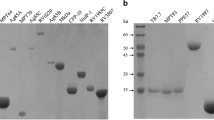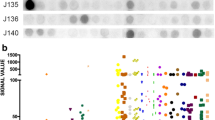Abstract
PPE68 is a Mycobacterium tuberculosis-specific protein which is absent from the vaccine strains of BCG. A panel of 14 PPE68-derived peptides predicted to bind to HLA-A*0201 was synthesized. The HLA-A*0201 restriction of these peptides was determined in T2 cell line and HLA-A*0201 transgenic mice. The specificity of peptides was assessed in pulmonary tuberculosis (TB) patients using IFN-γ enzyme-linked immunospot (ELISPOT) assay, and immunodominant peptides were further used to evaluate their diagnostic potential in HLA-A*0201-positive pulmonary TB patients. 13 out of 14 peptides were identified as high-affinity binders. Of these peptides, 12 peptides induced significant IFN-γ-secreting T cell response in transgenic mice and 9 peptides were efficiently recognized by peripheral blood mononuclear cells of 10 HLA-A*0201-positive TB patients. Four immunodominant HLA-A*0201-restricted epitopes (PPE68126–134, PPE68133–141, PPE68140–148, and PPE68148–156) were recognized by the most of 80 HLA-A*0201-positive TB patients (81, 86, 74, and 84 %, respectively). These epitopes may be used for a potential diagnosis of M. tuberculosis infection.




Similar content being viewed by others
References
al-Ramadi BK, Jelonek MT, Boyd LF, Margulies DH, Bothwell AL (1995) Lack of strict correlation of functional sensitization with the apparent affinity of MHC/peptide complexes for the TCR. J Immunol 155:662
Arlehamn CS, Sidney J, Henderson R et al (2012) Dissecting mechanisms of immunodominance to the common tuberculosis antigens ESAT-6, CFP10, Rv2031c (hspX), Rv2654c (TB7.7), andRv1038c (EsxJ). J Immunol 188:5020
Behr MA, Wilson MA, Gill WP, Salamon H, Schoolnik GK, Rane S, Small PM (1999) Comparative genomics of BCG vaccines by whole-genome DNA microarray. Science 284:1520
Brock I, Weldingh K, Leyten EM, Arend SM, Ravn P, Andersen P (2004) Specific T-cell epitopes for immunoassay-based diagnosis of Mycobacterium tuberculosis infection. J Clin Microbiol 42:2379
Chang KM, Gruener NH, Southwood S, Sidney J, Pape GR, Chisari FV, Sette A (1999) Identification of HLA-A3 and-B7-restricted CTL response to hepatitis C virus in patients with acute and chronic hepatitis C. J Immunol 162:1156
Cockle PJ, Gordon SV, Lalvani A, Buddle BM, Hewinson RG, Vordermeier HM (2002) Identification of novel Mycobacterium tuberculosis antigens with potential as diagnostic reagents or subunit vaccine candidates by comparative genomics. Infect Immun 70:6996
Cockle PJ, Gordon SV, Hewinson RG, Vordermeier HM (2006) Field evaluation of a novel differential diagnostic reagent for detection of Mycobacterium bovis in Cattle. Clin Vaccine Immunol 13:1119
Demangel C, Brodin P, Cockle PJ, Brosch R, Majlessi L, Leclerc C, Cole ST (2004) Cell envelope protein PPE68 contributes to Mycobacterium tuberculosis RD1 immunogenicity independently of a 10-kilodalton culture filtrate protein and ESAT-6. Infect Immun 72:2170
Duan ZL, Wang ZB, Guo JL et al (2013) Two novel squamous cell cancer antigen-derived HLA-A*0201-binding peptides induced in vitro and in vivo CD8+ cytotoxic T lymphocyte responses. Int J Oncol 42:1482
Ewer K, Deeks J, Alvarez L, Bryant G, Waller S, Andersen P, Monk P, Lalvani A (2003) Comparison of T-cell-based assay with tuberculin skin test for diagnosis of Mycobacterium tuberculosis infection in a school tuberculosis outbreak. Lancet 361:1168
Fuss IJ, Kanof ME, Smith PD, Zola H (2009) Isolation of whole mononuclear cells from peripheral blood and cord blood. Curr Protoc Immunol. doi:10.1002/0471142735.im0701s85
Jasmer RM, Nahid P, Hopewell PC (2002) Clinical practice. Latent tuberculosis infection. N Engl J Med 347:1860
Khanna R (2004) Predictive algorithms and T cell epitope mapping. J Immunol 173:2895
Kuttler C, Nussbaum AK, Dick TP, Rammensee HG, Schild H, Hadeler KP (2000) An algorithm for the prediction of proteasomal cleavages. J Mol Biol 298:417
Liu XQ, Dosanjh D, Varia H, Ewer K, Cockle P, Pasvol G, Lalvani A (2004) Evaluation of T-cell responses to novel RD1- and RD2-encoded Mycobacterium tuberculosis gene products for specific detection of human tuberculosis infection. Infect Immun 72:2574
Mazurek GH, Jereb J, Vernon A, LoBue P, Goldberg S, Castro K, IGRA Expert Committee; Centers for Disease Control and Prevention (CDC) (2010) Updated guidelines for using interferon gamma release assays to detect Mycobacterium tuberculosis infection-United States, 2010. MMWR Recomm Rep 59:1
Meier T, Eulenbruch HP, Wrighton-Smith P, Enders G, Regnath T (2005) Sensitivity of a new commercial enzyme-linked immunospot assay (T SPOT-TB) for diagnosis of tuberculosis in clinical practice. Eur J Clin Microbiol Infect Dis 24:529
Mukhopadhyay S, Balaji KN (2011) The PE and PPE proteins of Mycobacterium tuberculosis. Tuberculosis 91:441
Mustafa AS, Al-Attiyah R, Hanif SN, Shaban FA (2008) Efficient testing of large pools of Mycobacterium tuberculosis RD1 peptides and identification of major antigens and immunodominant peptides recognized by human Th1 cells. Clin Vaccine Immunol 15:916
Okkels LM, Brock I, Follmann F et al (2003) PPE protein (Rv3873) from DNA segment RD1 of Mycobacterium tuberculosis: strong recognition of both specific T-cell epitopes and epitopes conserved within the PPE family. Infect Immun 71:6116
Otahal P, Hutchinson SC, Mylin LM, Tevethia MJ, Tevethia SS, Schell TD (2005) Inefficient cross-presentation limits the CD8+ T cell response to a subdominant tumor antigen epitope. J Immunol 175:700
Pai M, Zwerling A, Menzies D (2008) Systematic review: T-cell-based assays for the diagnosis of latent tuberculosis infection: an update. Ann Intern Med 149:177
Rammensee H, Bachmann J, Emmerich NP, Bachor OA, Stevanović S (1999) SYFPEITHI: database for MHC ligands and peptide motifs. Immunogenetics 50:213
Ramos JM, Robledano C, Masiá M, Belda S, Padilla S, Rodríguez JC, Gutierrez F (2012) Contribution of interferon gamma release assays testing to the diagnosis of latent tuberculosis infection in HIV-infected patients: a comparison of QuantiFERON-TB Gold In Tube, T-SPOT.TB and tuberculin skin test. BMC Infect Dis 12:169
Rustomjee R, Diacon AH, Allen J et al (2008) Early bactericidal activity and pharmacokinetics of the diarylquinoline TMC 207 in pulmonary tuberculosis. Antimicrob Agents Chemother 52:2831
Scarpellini P, Tasca S, Galli L, Beretta A, Lazzarin A, Fortis C (2004) Selected pool of peptides from ESAT-6 and CFP-10 proteins for detection of Mycobacterium tuberculosis infection. J Clin Microbiol 42:3469
Tan JM, Tang XD, Xie T et al (1998) DNA typing for HLA-A, B antigens by polymerase chain reaction with sequence-specific primers and clinical application. Natl Med J China 78:763
van der Burg SH, Visseren MJ, Brandt RM, Kast WM, Melief CJ (1996) Immunogenicity of peptides bound to MHC class I molecules depends on the MHC-peptide complex stability. J Immunol 156:3308
Wang Y, Sun M, He M et al (2012) Weak binder for MHC molecule is a potent Mycobacterium tuberculosis-specific CTL epitope in the context of HLA-A24 allele. Microb Pathog 53:162
Wen JS, Duan ZL, Jiang LF (2010) Identification of a dengue virus-specific HLA-A*0201-restricted CD8(+) T cell epitope. J Med Virol 82:642
World Health Organization (2014) Global tuberculosis report. World Health Organization, Geneva
Zhou M, Xu D, Li X et al (2006) Screening and identification of severe acute respiratory syndrome-associated coronavirus-specific CTL epitopes. J Immunol 177:2138
Zhu BF, Yang G, Shen CM et al (2010) Distributions of HLA-A and -B alleles and haplotypes in the Yi ethnic minority of Yunnan, China: relationship to other populations. J Zhejiang Univ Sci B 11:127
Acknowledgments
The work was funded by the National Natural Science Foundation of China (30972763, 81261160323, 81172811, 81171576 and 31070143), National Science and Technology Key Projects for Major Infectious Diseases (2013ZX10003001), the Natural Science Foundation of Zhejiang (LY13H160035 and LQ14C010006), the Planned Science and Technology Project of Ningbo (2012A610247), and the Planned Science and Technology Project of Zhejiang (2014C33261).
Author information
Authors and Affiliations
Corresponding authors
Additional information
Zhi-liang Duan and Qiang Li have contributed equally to this work.
Electronic Supplementary Material
Rights and permissions
About this article
Cite this article
Duan, Zl., Li, Q., Wang, S. et al. Identification of Mycobacterium tuberculosis PPE68-Specific HLA-A*0201-Restricted Epitopes for Tuberculosis Diagnosis. Curr Microbiol 70, 769–778 (2015). https://doi.org/10.1007/s00284-015-0786-x
Received:
Accepted:
Published:
Issue Date:
DOI: https://doi.org/10.1007/s00284-015-0786-x





